|
 |
|
In 1893 thoughts turned to the
opening of a public park in Tipton, when the Local Board
of Health formed a sub-committee to discuss the matter,
after receiving a petition from 860 ratepayers. At the
time nothing was done, but the idea didn’t go away.
In May 1897 a meeting was held at
St. Martin’s School in Church Lane to decide what could
be done to commemorate Queen Victoria’s Diamond Jubilee.
At the meeting, the Chairman, Daniel Hipkins, mentioned
that a Tipton resident had offered to give a donation of
£500 towards the building of a public park, providing
that the remaining sum would come from public
subscription.
Initially plans were made to purchase an area of land at
the bottom of Upper Church Lane, but this fell through.
At the time, 34 acres of derelict mining land alongside
Victoria Road (then called Randle’s Lane) were for sale
at a cost of £1,500. The land was soon acquired and
reclamation work got underway. The site contained a
number of mine shafts that had to be filled-in, as well
as a large pit mound containing around 60,000 to 70,000
tons of spoil, which had to be removed. The spoil was
used in the construction of several new roads and to
fill-in a large marl hole in readiness for the building
of houses. |
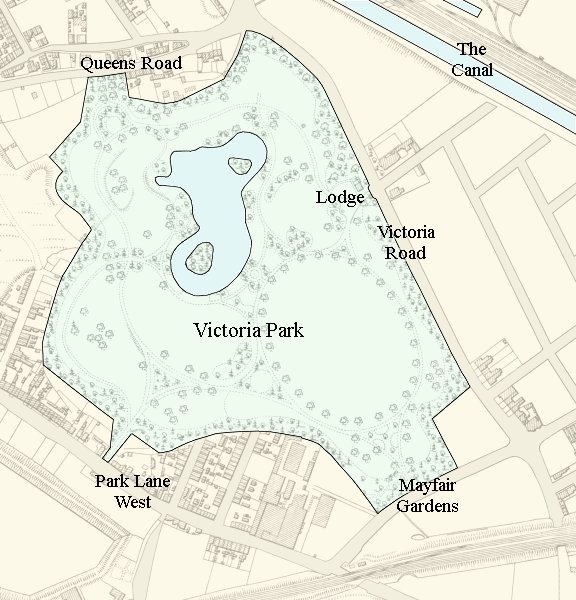
Victoria Park in 1901.
|
In 1898, plans for the park
were submitted by several contractors. The design
chosen was produced by William Barron and Sons of
Borrowash, Derbyshire. The firm gained a reputation
as excellent landscape designers. The landscape work
was carried out by T. Allsop of Tipton and the lodge
(which no longer survives) was built by J. Gittings
of Tipton. The fencing was provided by Hill and
Smith of Brierley Hill and around 15,000 trees and
shrubs were planted.
Several gifts were made for the
park including the ornate drinking fountain that was
given by Mr. and Mrs. G. M. Waring to commemorate
their golden wedding. Mr. Waring was clerk to the
Local Board of Health and the Urban District
Council, for 42 years. A cast iron canopy called the
‘Umbrello’ was erected over the fountain. It was
built to a design produced in 1860 by Walter
Macfarlane & Company of Glasgow. Although the
fountain was moved, the ‘Umbrello’ still stands. It
has a domed top that is supported by eight columns
with an arch between each column. Above each arch is
a shield, ornamented with herons. One of the shields
carries an inscription which records Mr. and Mrs.
Waring’s donation. An anonymous donor provided funds
for a children’s gymnasium and shelter, while others
gave seats, a peacock, a peahen and two swans.
Victoria Park opened on 29th
July, 1901 and was named in honour of Queen
Victoria, who died on the 22nd January 1901. The
park was built at a cost of £6,500. The park was
opened by the Earl of Dartmouth on a beautiful
summer’s day. The official procession to the park
started at the old public offices in Owen Street and
included the Earl of Dartmouth, escorted by a guard
of honour from the rifle volunteers. There were
mounted policemen, members of the Urban District
Council, the mayors of Dudley, Wednesbury and West
Bromwich, Mr. Walford Davis Green the local M.P. and
the County Magistrates. Others included members of
the School Board, the Tipton Rifle Volunteers, the
Princes End Prize Band and the Dudley Port Band,
Tipton Boys Brigade, members of the fire brigade,
and members of local friendly societies.
Large numbers of people lined
the streets to view the procession which stopped
outside the park beside the entrance gates which had
been decorated with an archway that carried the
words 'Success to our Park'. After prayers had been
given by the Vicar of Tipton, the Reverend T. Wilson
de Vine, the Earl was presented with a gold key
which he used to unlock a silver padlock on the
gates before the party entered the park. The party
then inspected the park and attended a luncheon that
was held in a large marquee, erected on the cricket
pitch. |
|

An early view of the lake.
From an old postcard. |
|
At the northern end of the park
is a bowling green that dates from the early 1900s.
It provides crown green bowling for anyone over the
age of 14. It is the home of Victoria Park (Tipton)
Bowling Club.
A bandstand was erected in 1910
which survived until around 1960. In 1921 the War
Memorial in the form of a pale granite obelisk above
an inscribed grey granite tapered plinth, was
unveiled by the Marquis of Cambridge on the 24th
August, 1921. The memorial commemorates the local
people who lost their lives in both World Wars. |
|
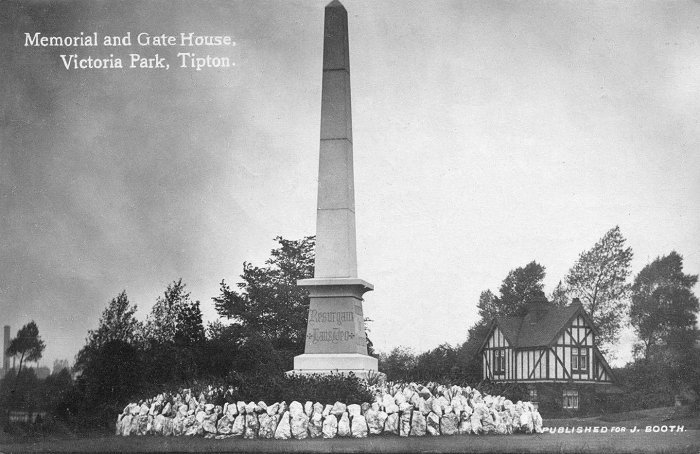
The War Memorial. From an old
postcard. |
|
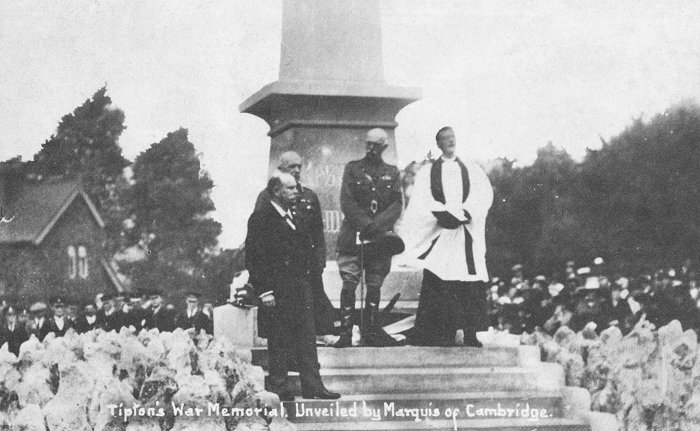
The unveiling ceremony. From
an old postcard. |
|
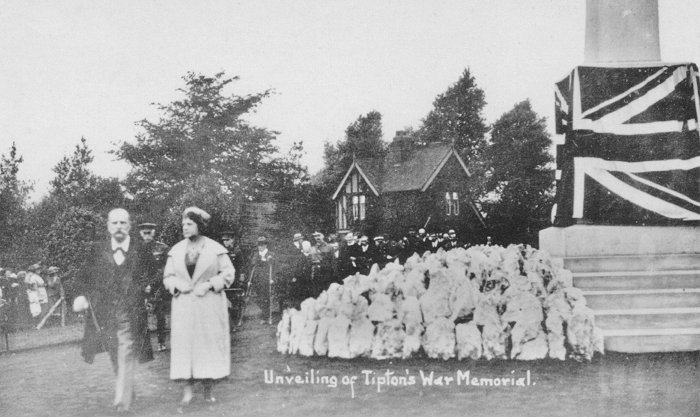
Another view of the unveiling
ceremony. From an old postcard. |
|
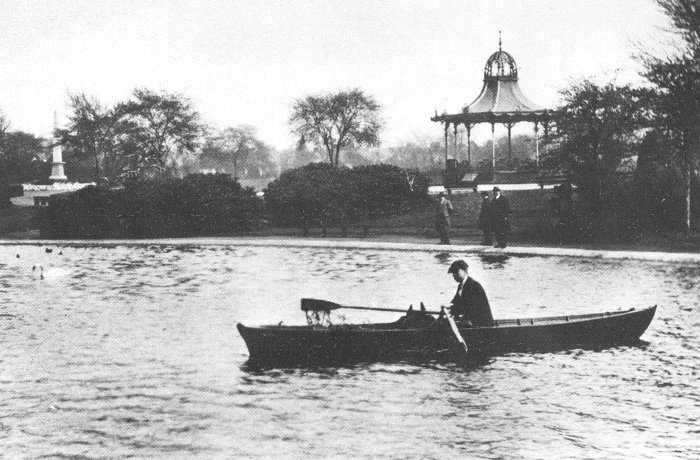
A view of the lake from
the mid 1920s, with the war memorial and the
bandstand behind. |
|
The two storey park keeper's house
dates from the early 1920s and a single storey
refreshment pavilion with rough cast walls above an
exposed brick plinth was built around 1930. A Sons of
Rest shelter was built in the park in 1961 and the park
was extended to the south west when properties in Park
Lane West were demolished in the late 20th century.
The park is now very popular thanks
to its children’s play areas, tennis courts, grass
sports pitches, skate park, ornamental lake, and gym
equipment.
Two other public buildings were
constructed next to the park. The first is the Public
Library, a gift from Andrew Carnegie, the Scottish born
American historian and philanthropist, designed by
George Wenyon and built in 1905. It opened in 1906 and
closed in 2000. It reopened as Sandwell Council’s
Occupational Health Unit and became the Tipton Carnegie
Centre. The second is the Public baths designed by H. N.
Woodard and built on the north western corner of the
site in 1932. |
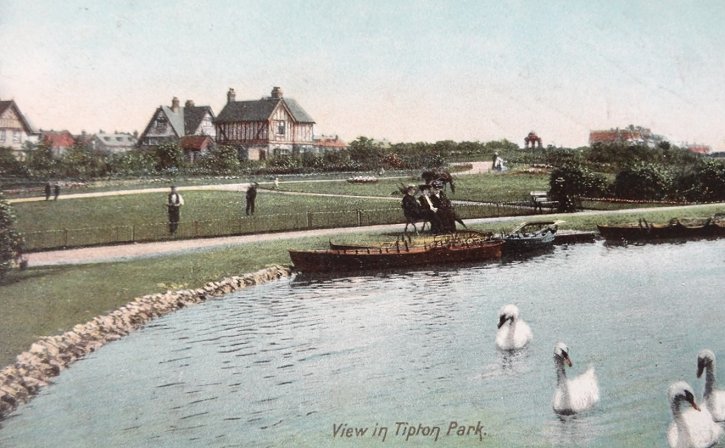
From an old postcard.
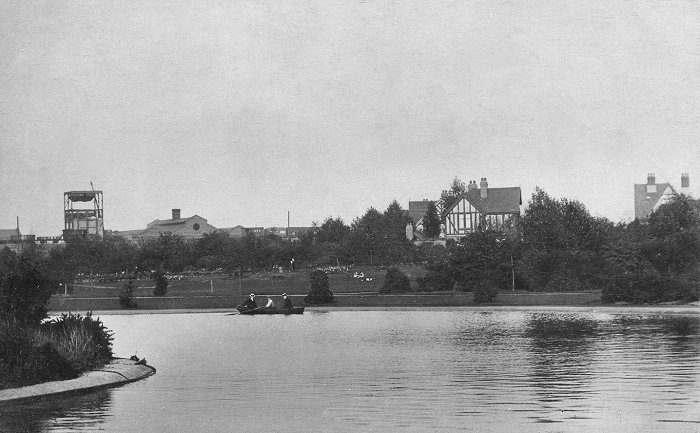
A second view of the lake. From an old
postcard.
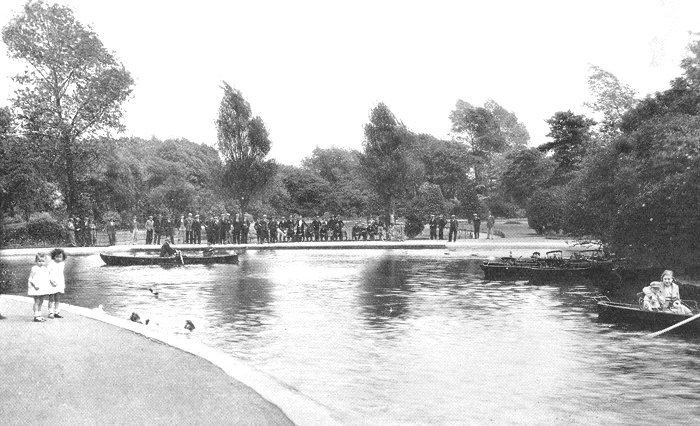
The lake in the 1930s.
|
 |
 |
 |
|
Return to
Local Government |
Return to
the
beginning |
Proceed to
Industries |
|